FAQs About Red Ear Slider Turtle
Disease/Health: Growths/Tumors
Related Articles:
Treating Common Illnesses of the Red Ear Slider (& other Emydid Turtles) by Darrel
Barton,
The Care and Keeping of the Red Eared Slider, Trachemys
scripta elegans by Darrel Barton, Turtle eye diseases;
Recognising and treating eye diseases in pet turtles
by Neale Monks, So your turtle has the
Flu? Recognising and treating respiratory infections in pet
turtles by Neale Monks, The Care
and Keeping of the Red Eared Slider, Trachemys scripta
elegans by Darrel Barton, Red Ear Sliders, Turtles, Amphibians, Red Eared Slider Care, Shell Rot in Turtles,
Related FAQs: RES Disease/Health 1, RES Disease/Health 2, RES Disease 3, RES
Health 4, RES Health 5, RES Health 6, RES
Health 8, RES Health 9, RES Health 10, & Shell Rot, Turtle Disease 1, Turtle Disease 3, Shell Rot, Turtle Respiratory Disease, Turtle Eye Disease,
FAQs on RES Health by Type: Diagnosis, Environmental, Traumas, Social, Nutritional, Infectious, Parasitic, References,
& Sliders 1, Sliders 2, Red Eared
Slider Identification, RES
Behavior, RES Compatibility,
RES Selection, RES Systems, RES
Feeding, RES
Reproduction,
|
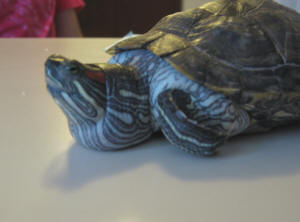
|
|
Red eared slider mom 7/10/16
Dear Crew
<Hiya – Darrel here>
I love all the info, it's funny.
<Be sure to tip your waiter>
I have had turtles in my life from age 6, I just have one now I got her when
I was 13 and I'm 54 now so when I read expect 30 year commitment... try 41
and still going strong.... murtle the sweetest girl so smart amazing pets,
but not for everyone... it's a daily commitment and attention to every
detail, all and any different behavior, the ancient Chinese i ching
describes turtles as the connection between heaven and earth! Heavenly
divine creatures we are blessed to have in our lives....
<I agree … except when they steal your credit card and go on an on-line
shopping spree. Turtles have no financial discipline at all!>
Her shell is abnormal because of my lack of education when I was a teen....
I constantly read and it's so great to have website like yours.... thank you
for the blessing of continued knowledge.... I also had a firebellied toad
that lived 28 years I rescued from a garage and a few other I took from a
classroom.... teacher have no business having animals unless the teacher to
respect all living things....
<except politicians and door-to-door salesmen>
Carolyn
<Carolyn, on behalf of Bob, Neale, Sue and the crew, thanks for your kind
words. It’s letters like that that make us feel good about what we do. It
sure isn’t the money … we’re chained up here in the basement of the Flemner
Building in San Diego and all that sustains us is the kind words … and the
free food. So thanks!>
|
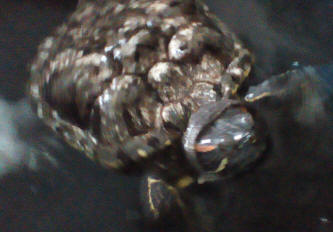 |
|
Turtle growth 12/29/15
Hi –
<Hiya – Darrel here>
Attached are pics of a growth on my red eared slider. I've been treating him
with warm soaks, rinsing the area with peroxide and anti fungal cream twice
daily.
<Won’t help>
The lump is firm in the center and fleshy around it. There is also a small area
like this coming out of the other rear leg hole in his shell. Any advice is much
appreciated. Sam is about 9 years old.
Thank you,
Colleen
<That is a growth of some sort, not an infection, so soaking it won’t help. It
is very likely a fatty tumor. The treatment is to have a veterinarian excise it
or at least stick a needle in and see what they can draw out. If a veterinarian
is not available, look online in your area for a turtle and tortoise club. You
will likely find an experienced ‘old hand’ that has excised many fatty tumors>
|
 |
|
Re: Turtle growth 1/6/15
How would you numb or anesthetize them? For removal of the tumor? Or could he
just live with it?
<They are remarkably tolerant and resilient. If it was me I'd immobilize the
area and excise the tumor, cover the area with Betadine twice daily and keep her
warm and dry for two weeks. Most numbing agents that are effective on turtles
have more side effects than benefits.>
Re: Turtle growth 1/6/15
Dear Crew
<Hi>
Is there any reason not to just let it be? I looked for someone here in NJ but
can't find anyone. I can't spend the 80$ on the vet consult that the reptile
specials wants.
<yes, and the $80 would be for the consult - then $125 more for surgery, etc. so
I understand>
<The think about tumors is this: It may be benign or it may be cancerous. It may
have spread, but it may not have. So there is so much more we don't know that we
DO know - there isn't a right answer. If it doesn't impact the turtle's movement
or digestion then there's not driving reason to remove it.>
Thank you for your help!
|
|
lump on RES's neck 2/7/14
Hi,
<Ana; our turtle folks appear to be MIA; I will direct you to our (WWM)
search tool and otherwise suggest you simply read here:
http://www.wetwebmedia.com/FWSubWebIndex/RESDisTumorF.htm
and the linked files above. Bob Fenner>
Today I noticed a lump on the left side of my turtle's neck, below the red
marking on the side of his head. He is a 15-year-old RES; he eats well,
basks under his UV/ heat lamp, and does not seem to be ill (I know his shell
doesn't look too good; he has been having a scute-shedding problem for a
couple of years). The lump is the same colour as the rest of his skin.
I check him daily, but the lump isn't visible from all angles, though it is
rather large, so I'm not sure how long it's been there. Is it an ear
infection, or could it be caused by an improper diet with too much protein?
I live in a country where there are no reptile vets, so I really need your
help.
Thank you.
Ana
|
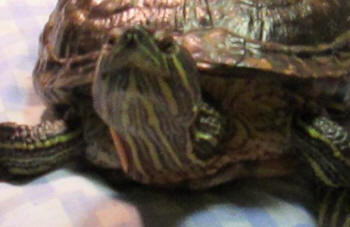
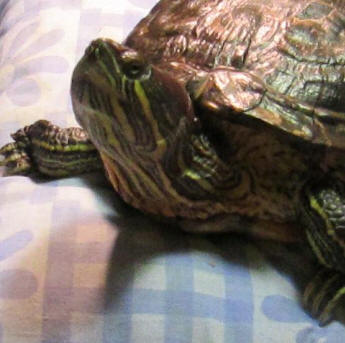
lump on RES's neck 2/7/14
Hi,
<Hiya - Darrel here>
Today I noticed a lump on the left side of my turtle's neck, below the red
marking on the side of his head. He is a 15-year-old RES; he eats well,
basks under his UV/ heat lamp, and does not seem to be ill (I know his shell
doesn't look too good; he has been having a scute-shedding problem for a
couple of years). The lump is the same color as the rest of his skin.
<That's because it's a growth under the skin>
I check him daily, but the lump isn't visible from all angles, though it is
rather large, so I'm not sure how long it's been there. Is it an ear
infection, or could it be caused by an improper diet with too much protein?
<It could be an ear infection, but it could also be benign cyst of fatty
tissue. The only way to know is to excise it and see>
<Turtles don't get ear infections from too much protein. If she's not
fat and puffy, her eyes are clear and bright, her shell is firm and she is
active, them I'm thinking the diet is good enough. A good
quality Koi pellet is a perfectly balanced diet and it's inexpensive.
An occasional earthworm as a treat (or a small piece of beef or chicken
liver) is an excellent way of seeing that they get the vitamins they should
have.>
I live in a country where there are no reptile vets, so I really need your
help.
<OK - but this will be a bit tricky. At some point someone is going to
have to poke a needle through the thickest part of the bulge and try to draw
out what fluid may be in there. In the alternative, if no fluid flows,
the needle will hit either a bone (no worries, it's just then a bone growth)
or a mushy mass, which would be a cyst.>
<The tricky part, really, is getting her still enough to do that. The
trick is to push her hind feet in tight which causes their heads to stick
out a bit - and then also push their front legs together and inward so that
it blocks their heads from retracting. This takes practice and
patience but it can be done.>
<As far as reptile vets, a simple excision can be done by just about anyone,
even someone that has had some extensive first aid training. What I
would suggest is look on the internet for any kind of turtle or reptile
clubs within a reasonable distance and see if you can find someone that,
like you, has had to learn by doing.>
<Now, once the area has been aspirated or the cyst excised, Dry-Dock her as
described below while she heals.
http://www.wetwebmedia.com/FWSubWebIndex/treating%20RES%20Dis%20DarrelB.htm
>
Thank you.
Ana
|
Red Ear Slider with growth near his
ear. 10/15/11
Hi my name is Laken.
<Hiya Laken - I'm Darrel>
I have a Red Ear Slider named Tots. I've had him for about a week
now and he was all good until yesterday I noticed a yellowish growth
(looks more like a pimple) on or near his ear (but it is on the red
strip). It's mostly covered by his extra skin around his neck but u
can see a slight bulge under the skin and only if he stretches his neck
all the way out you are able to see the growth.
<Typically that's a pocket of infected skin. Sometimes it can be
a benign cyst, but the yellow color indicates fluid under the
skin.>
I don't have a heater, UVB light or heat lamp at the moment, could
that be the cause for the growth? I have done research and read other
cases on your site, but because this is yellowish in colour I wonder if
it's something else?
<No. You probably don't need a heater unless you live somewhere
terribly cold, but you should have a UV-B lamp and a basking
lamp.>
<In any case, those are not the cause of the infection.>
I've become really attached to him and I want to take the best
possible care of him. I understand I need the essentials, such as, the
UVB light and heat lamp, which I am going to get straight away, but
what can be done in the meantime to treat him?
<The infected area needs to be lanced and then treated with a
topical disinfectant, Laken. This is specifically the kind of case that
calls for a trained veterinarian, but I also have another suggestion.
Search the internet in your area for a Turtle and Tortoise Club.
I'd bet you will find one within a reasonable distance and it's
very likely that you can find someone who has been keeping turtles for
years someone who has the experience and can lance the wound and
disinfect it for you.>
I appreciate the help.
Thank you
Laken
<Your welcome. Laken - here are two links that cover EVERYTHING in
the basics that you need to know about Tots and turtles like him. You
can find much more information on WetWebMedia and on the Internet in
general and you should read as much as you can - but anything you read
that is contrary to these two articles is just plain wrong. So please
start here:
http://www.wetwebmedia.com/FWSubWebIndex/RESCareBarton.htm
http://www.wetwebmedia.com/FWSubWebIndex/treating%20RES%20Dis%20DarrelB.htm
Best of luck to you!>
Please help! Betta in a bowl 10/11/11
I bought my 2 year old son his first fish for his Birthday August 16,
2011.
The Beta fish is a beautiful blue color and we love him. He has been
doing well until a few days ago when he started staying at the top of
the tank.
He lives in an "old school" fish bowl with glass rocks
(easier to clean) and a plastic plant.
<Mmm, most Bettas don't live long or well in such...>
He still is eager to eat. He stays at the top of the tank and up
against the glass and at times rolls on his side. What is wrong with
him??? I called the pet store and they suggested adding salt which I
did but no change. They also suggested his tank might be too cold, so I
bought a tank heater and it stays close to 75 degrees.
<Needs to be a bit warmer... see the link below>
Can you please help, I don't
want him to die!
Sincerely,
Sherri
<Please read here re practical husbandry of this species:
http://wetwebmedia.com/FWSubWebIndex/bettasysart.htm
Bob Fenner>
Re: Betta in bowl 10/16/11
What about all those Bettas living in vases at peoples office, I would
think a large bowl like I have would be better than that.
<You may well think that. But while a 1 gallon bowl is
"better" than a half-gallon bowl, that's much the same as
saying losing just half your arm is better than losing the whole arm --
it's a difference without a distinction. Bettas do best, and live
longer, healthier lives in aquaria with heaters and filters. While
breeders may well use bowls in heated fish-rooms and will change the
water daily, taking care to keep water chemistry constant, this
isn't a viable way to do things for hobbyists. Most of those Bettas
in bowls and jars die prematurely, and the fact they're kept that
way -- and people are happy buying new Bettas every few weeks or months
-- says more about how callous people can be when it comes to animals
that can't bark, squeal, or otherwise show their distress. I'm
not trying to sell you anything, Alberta, but I am trained as a marine
zoologist and have spend the best part of 30 years keeping fish. So
when I say that a fish will be stressed, or killed, by being kept in a
certain way -- I'm simply stating facts. Whether you choose to
ignore reality and go ahead and do your own thing is your own choice,
like those nutcases who believe President Obama is a Muslim born in
Kenya.>
I don't have another tank or the space for one
<Ultimately, the point is this: if you don't have the space or
money for a pet animal, whether a German Shepherd dog or a little Betta
fish, you shouldn't keep that animal.>
Thanks again AN
<Cheers, Neale.>
Betta in bowl 10/16/11
<Hello Alberta> I just finally got all my fish happy in 2
different aquariums, where everyone is getting along. Now I have a
large 10 inch in diameter and 6-8 inch deep fish bowl..will a Betta
fish be happy in there
and if so what type of water should I use. We are using RO water for
the other aquariums and adding water conditioner to it .Thanks AN <I
wouldn't suggest putting a Betta in a bowl. Water volume isn't
the only consideration here. These fish are tropical and consistent
temperatures of around 80 degrees. With a bowl there is also the added
risk of the fish jumping out. You are far better off having a Betta in
a 5-10 gallon tank with filter and heater. You might even be able to
put in some live plants and shrimp. It can turn out quite pretty. I
have had a just such a tank for a long time and it is fascinating to
watch. As for your question on water, RO water is good for use but do
check the water parameters such as pH needed for the livestock you plan
to have. In the case of Betta for instance, you would want the water to
be slightly acidic. You can start to read about Betta care here -
http://www.wetwebmedia.com/fwsubwebindex/betta_splendens.htm
Good luck, Sugam>
|
Re Red Eared Slider - lump?
4/5/11
Well, since my last email I've been keeping a closer eye on
that one. he is active and seems to definitely be shy. If I
dangle a worm in the water the 2nd one will gladly come after it,
but I can't get the other one to bite at it no matter how
close I dangle it. I have noticed however that the shy one also
seems to have a rather large lump on the back of his neck. The
other one doesn't have any lump there and neither did the 3rd
one that a coworker of mine has. I've taken pics... and that
wasn't easy... I managed to get one pic that shows it before
I had to hold his head out in order to get more. Any idea what
that is on the back of his neck? it feels hard, but not hard like
his shell. and he still seems to be able to retract his head
fully without issue.
<I see it in the pictures and no, it's not normal. It
could be an infection but if it's hard, it's more likely
to be a cyst. Unfortunately, the treatment requires a trip to an
experience veterinarian. One suggestion I can make is that if you
can find a local turtle & tortoise club, you might find an
'old hand' that has treated enough of his own turtles to
be able to give YOU a hand without a trip to the vet>
<As far as his shyness goes once the treatment is over and
things can settle down a bit, you might find that he relaxes a
bit more. But right now, we have an immediate symptom we need to
address. Best of luck>
|
|
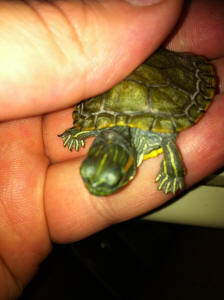 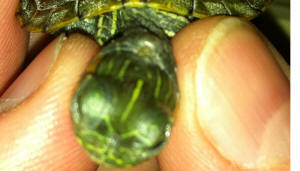
|
|
Red-eared slider blister? 7/13/10
Hi!
<Hiya - Darrel here>
I have a red-eared slider in a 10-gallon tank, just him in there.
He's acting normally, eating and cheerful as always,
<Glad to hear that he's cheerful, Anne. Nothing fun about
a sullen or moody Slider!>
but I noticed a clear sac-type thing on the bottom of one of his
rear feet. I've attached a photo of it, as I don't know
what exactly to call it. Is it a blister? It seems to have just
occurred, and I've never seen anything like this on him
before. It doesn't seem to hurt him when I touch it (which I
was doing to try to figure out what it is.) I'm not sure if
it's filled with liquid, but it doesn't look like it is.
And he's swimming around normally. But it's rather large,
right to the tip of the foot where the skin ends at the
claws.
<It's an odd thing to be sure. My guess is that it's
something growing ON him rather than from within him. To that
extent, let's take him out, dry him off and try to remove it.
First dry to brush it with a dry cloth, maybe an old toothbrush,
but if necessary, pull if off with tweezers. Clean the affected
area with hydrogen peroxide, let that dry and then dribble on
some Betadine. Let him stay dry overnight and put him back in his
tank the next day.>
Also, and this may be unrelated, he seems to have brown spots on
the underside of his shell. I've attached photos of that
too.
<Yeah -- there are two common causes of that discoloration.
The first one, worst one, is a septic infection. For that to
occur he'd be VERY sick and would have been sick for a very
long time. It's not likely if he's still active, eating
and happy. When a turtle become septic, the first thing he'll
typically do is stop thermoregulation: basking, swimming,
followed by more basking, etc. and he'll almost always be off
his feed>
<The second, far more common source is a simple discoloration
from rubbing against rocks or bricks something akin to a simple
stain.>
I've seen things like that in photos of turtles with fungal
infections, but mine doesn't seem to have any other symptoms
of a fungal infection. Are these brown spots normal? Or should I
be worried? (Well, I am worried, but should I continue being
worried?)
<Given the combination of symptoms, I'd treat him on the
assumption of a fungal infection (even if it's not
conclusive). Read the link below and treat him as if he had a
fungal infection for say two weeks and let's see how he
does>
Thank you!
Anne
<
http://www.wetwebmedia.com/FWSubWebIndex/treating%20RES%20Dis%20DarrelB.htm>
|
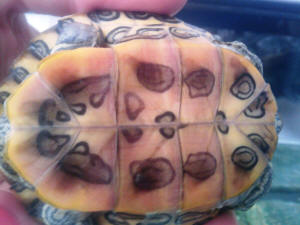 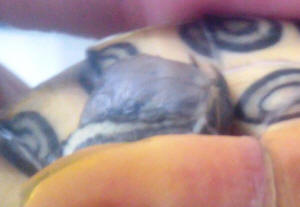
Upper left and crop |
Slider with bulge on side of head???
06/04/09
Hello W.W.M. Crew,
<Hiya John, Darrel here>
I have a Red Eared Slider that is still very small. Recently I noticed
that on one side of his/her head its beginning to bulge. I noticed a
white spot at first and just recently discovered that it is beginning
to bulge. This is isolated to one side of the head. What could be the
possible diagnosis,
<If the skin is bulging my guess is that the turtle has an abscess.
It could be a bacterial or fungal infection that started on the surface
and grew inward>
and can it become fatal?
<yes>
What are possible treatments?
<The only proper treatment is to have a veterinarian open the pocket
and express the contents, John. If it's bacterial or fungal then
cavity can then be washed with the appropriate agent and stitched --
and then a course of medicine. If it's some kind of actual growth,
then the opening becomes the first step in the surgery to
correct.>
<I'm sorry to say, John, this is not one to try at home>
Thanks,
John C. Mabe III
Re: Slider with bulge on side of head??? 6/30/09
Hello W.W.M Crew,
<Hello again -- Darrel here>
I have a Red Eared Slider as I have mentioned before, and the bulge has
completely disappeared, thanks for the advice.
<The only advice I gave was to have a veterinarian treat the
abscess. This sort of thing doesn't "disappear" on
it's own, John ... so if there was no treatment of the bulge, the
probably abscess burst & released the infection into the rest of
his system.>
The new thing is that he now has begun to have large gapping
breath's and kind of squeaked on occasions as he does. I noticed
that he is now sneezing and discharge is coming out of his mouth.
<There you go. Sneezing and discharge are -- at the very least --
signs of respiratory infection.>
He also has lost his appetite.
<Because he's very sick>
My guess is that the temp of the water might be to cold? Lately its
been around 72.0-74.0 degrees.
<Perfect water temp as long as the basking area is 85-90 degrees and
the turtle is able to move easily between the basking area and the
water.>
I have an under-water heater that is supposedly set to the optimum
temp??
<No water heart necessary for turtles, John. Any room temperature
you can live in is fine for their water as long as they can get out of
the water to get warm and dry>
Now that he has symptoms is there something I can do to cure him
besides getting a heater that works right??
Thank you very kindly,
John C.
<John, at this point I'd say that you're only real hope is
an experienced veterinarian. He HAD symptoms before (a bulge on the
neck, remember?) that wasn't properly treated ... and now things
are much worse.>
<I realize that, for many people, a trip to a vet is simply out of
the question .. and that leaves us with second and third rate
treatments .... very poor substitutes ... that will almost certainly
not really help. In this case, the only thing left to you is to take
the turtle out of the tank entirely:>
<so:>
<Recognize immediately that the very environment preferred by the
turtle, warm and wet ... is also the optimal environment for the growth
of fungus and bacteria -- and even if neither are the primary illness,
you can be assured that if you leave a sick turtle in a warm, wet
environment long enough, fungal AND bacterial will seize the
opportunity to take hold and take over. For this reason, the single
most immediate treatment for any illness in a turtle is to remove them
from their tank, pond or enclosure and place them somewhere warm and
dry. Remember that, in the wild, water turtles occupy the habitat
AROUND the water as much, if not more than IN the water. Moreover, a
turtle in good health can survive months out of water and a sick turtle
really needs the rest.
A temporary shelter can be anything from an empty aquarium to a plastic
bin or trash can or even just a cardboard box with high sides (keep in
mind a determined turtle is an incredible climber). Add a heat source,
which can be a regular electric heating pad (if you're lucky enough
to be able to find one without the annoying 'automatic off'
feature) to a light bulb suspended over head. Ideally you want to
achieve a constant temperature of between 85-87 degrees. Since we are
deliberately taking away the turtle's choice to move from cool to
warm, we have to pick a constant that fits both needs. NOT having to
move between temperature zones and not having to swim or climb is the
first step on giving the turtle the ability to direct
his attention more toward healing.
You must also provide UV-A and UV-B light sources(NOTE 2), which
perhaps can be moved from his original enclosure or -- in the
alternative, a minimum of 10 minutes of direct (NOT filtered through
any kind of glass or screen) three times a day.
Assuming he is healthy enough to be moving, the regimen will be to
place him in a shallow container of luke warm (room temp) tap water
every day for 5 minutes in order for him to drink, poop and possibly
eat. Shallow means no more than half his shell under water when you
place him in it -- and really only enough to cover his tail and cloaca.
Assuming that he is being treated for his actual condition and
improving, he can go YEARS in this condition without ill
effects.>
<John, this MAY help the little guy's immune system be a bit
more able to fight off the infection, but I doubt it>
|
Swollen neck, RES 5/4/2009
Hi,
<Hiya, Darrel here>
I have a female Red Eared Slider that is about 3 years old and
about 6 inches long. A few weeks ago I started noticing her neck
puffing up and it is so swollen now that she cant even get it
into her shell. Her head can go in most of the way but not all
the way. The rest of her body parts are swollen as well but not
as much as her neck. What can this be and what can I do to help
her?
<Swelling covers a lot of territory, Jewel -- from infections
to obesity and a number of issues in-between. First, did she just
START swelling a few weeks ago -- or did you just notice a few
weeks ago? Has it gotten worse since you noticed -- or is it the
same? Is she active and eating -- or listless? Does she climb out
and bask for reasonable periods? When she swims, does she have
trouble submerging as if she keeps floating UP -- does she have
problems floating as if she can't help but sink -- or seem
fine in this regard? What about her skin -- is it normal looking,
faded colors or appear to be covered in a gray film?>
<Does she have clean, clear water and proper UV lighting in
her basking area?>
<If you can provide us with some answers to these questions
and a better description of the swelling itself, we can be more
helpful in diagnosing.>
<In the mean time, if there's any question AT ALL about a
health problem, remover her from her tank and keep her some
-place warm and dry ( I often just use a high sided cardboard box
with an heating pad set on low). just about every illness that a
Slider can contract is made worse in a warm, wet environment, so
take her out, keep her warm and dry and then place her in a
shallow bowl of room temperature water for 10 minutes every day
just so she can drink, eat and poop.>
<And please write back with more specific information>
Jewel
Re: Swollen neck 5/5/09
Hi
<Hiya, Darrel here>
First off, if I accidentally call her a him, it's because we
just found out he's a she a short time ago. And thank you
sooooo much for being here and helping me!! I've called
places and gone to 2 reptile stores and they had no clue what it
would be.
I hate to say it but although I look at her several times a day,
I can't even tell you when she started to swell but I have a
photo of her from 1/5/09 and she was looking normal. The swelling
is pretty much the same
since looking at her 2 weeks ago.
<OK>
She does not act listless although her eating drive is not as
ambitious as it was a couple of weeks ago. I did buy new food for
her (turtle food) and was feeding it to her for about 1 week
before noticing her neck. I stopped feeding it to her when I
noticed it. There was also approx 12 feeder fish in the tank that
had gotten large because she could not catch them.
<That's a common problem, Jewel. Fish are not a
significant part of a turtle's diet and as I'm sure you
can imagine, Sliders aren't really adept hunters .. so the
fish grow bigger and just add to the fouling of the
water.>
The water was definitely not clear. I got rid of all of the fish,
cleaned the tank and dropped the temp in the tank to about 78
degrees (it had been at 82-84 degrees).
<The water temperature should be around 72-73 degrees and no
warmer.
Turtles kept indoors should not have a heater of any kind in the
water.
With proper basking temperatures, the idea is that the turtle
will choose her own temperature by basking to warm up or swimming
to cool off, so get that water temperature down please>
She stays mostly in the water or half in and half out because she
gets skittish when basking on the pad. I don't know if she
even knows how to really swim because her tank has never been big
enough to make any waves.
She seems to just sink when I try to show her how its done in the
bathtub. There is a UV light that I leave on all day and eve and
just shut off at night. It is approx 9 months old. And a heat
lamp over the basking area.
Her skin right now is shedding in very thin pc.s of clear or
grayish color.
I think I can download a photo of her if that will help.
<Read the instructions very carefully on the UV bulb, Jewel.
UV bulbs typically have to be very close -- which is to say that
an average bulb loses more than half it's energy at 8-10
inches from the surface. In fact,
at 24 inches above the tank they have no really value at
all.>
<For the moment, keep her warm and dry for a week (as I
suggested yesterday) and let's see if a less stressful
environment will allow her condition to improve.>
Thank you again!
Jewel
<Here's a link for you
http://www.wetwebmedia.com/FWSubWebIndex/RESCareBarton.htm
>
<check every aspect of your care against what's written
and correct anything that is out of line>
Re: Swollen neck 5-7-09
Here's a couple of pics of my RES.
Jewel
<Jewel, that's more than a swollen neck. That's
what's called edema -- a swelling of the tissues with excess
fluids. It could because the kidneys are not eliminating, a
bladder problem or any number of other issues, all serious and
all requiring veterinary care. Best case it's a vitamin
deficiency, Vitamin A&D most likely .. but at this stage
you'll need a vet to give injections. Oral application
wouldn't get enough into the tissues fast enough.>
<I'm sure that's not the help you were hoping for, but
that is, as they say, they way it is.>
<Best of luck to you ... Darrel>
|
 |
Re:
Swollen neck 5-7-09
Thanks Darrel,
I actually took her to a vet this morning. He thinks she has some
sort of infection as well as respiratory problems. Mostly all due
to bad water conditions (which was my best guess). He gave the meds
to me to administer
every 3 days. Boy this will be fun! Never gave a shot in my life!
Wish me luck!
Thanks for your help,
Jewel
<Best of luck to you and little Molly>
<To everyone else, I'd like to take this opportunity to
mention that the amount of money and effort that Jewel is going to
spend on treating this illness is many, many, MANY times the cost
and effort of having prevented
the illness in the first place! Whether it be fish, foul, furry or
slithery .... it costs less time, less money and less heartache for
prevention than for treatment.>
<That is all.>
<carry on> |
Turtle With Bump on Cheek -4/23/09
Hi,
<Hiya back! Darrel here>
I have a two inch red-eared slider named Leafy that has a white bump on
its cheek. I'm wondering what it is and what I can do to remove
it.
<I'd need more information than that description. Growths from
under the skin usually look like a bump, but in the color of the skin
itself. A WOUND can often scab over and look a little whitish after the
scar forms, but then a FUNGUS will be white or white/gray and will look
somewhat fuzzy.>
I feed it ReptoMin sticks and shrimp. I wash the tank every week and
feed it every other day.
<That sounds like good care. What about lighting? UV lamp and a
basking lamp for heat? Unfiltered sunlight (most people don't
realize that ordinary glass filters out UV). What is the rest of the
environment?>
I waited a few days to see if it would go away by itself but it
didn't. I got it from Chinatown and it's my first turtle. What
should I do to help?
<Here's a link about our many responses to fungus
http://www.wetwebmedia.com/FWSubWebIndex/resdisf3.htm>
<If you think we've described a fungus, you can get ideas on how
to treat it. Otherwise try to send us a couple pictures>
<And here's a link to general standards of care.
http://www.wetwebmedia.com/FWSubWebIndex/RESCareBarton.htm>
Compare your standard of care and correct anything missing
Re: Turtle With Bump on Cheek -4/23/09 05/02/09
It's just white and it looks like it's part of the skin, but
it's bulging out.
<It sounds like an infection has taken hold>
I bring it to a non-direct sunlight area every few days.
<Unfortunately, he needs direct, unfiltered sunlight every day
--or-- a set of Ultraviolet A/B lamps. Without this he'll never be
able to synthesize the vitamins he needs>
His tank has pebbles covering the bottom and a flat rock. There is a
little one-inch tower and a fake plant that he likes to climb on top
of.
<As long as he can get out and completely dry and warm -- again,
anything the "care" link has that you don't have ... must
be fixed>
I think it's about to die. He takes really deep breaths, moving his
whole head, and he's all stretched out. My brother rolled him on
it's back but it didn't move.
<Well, put him back upright, take him out of the water and keep him
someplace warm and dry. OUT of water. To be honest it sounds like
he's too sick to be treated. At minimum he'll need to be seen
by a veterinarian that can diagnose and treat him.>
What do I do? Should I get a new turtle?
<No, please don't. If this turtle passes away it's important
that you understand what went wrong and CHANGE things -- before getting
another.
The little guys in our care depend on us 100% for heat, light, food and
safety and we owe it to them to learn from our mistakes.>
<In your case, read the link AGAIN ... do further research on the
WWM site and do NOT get another turtle until you understand all the
care it needs and that you're sure you can provide that
care>
<We here at WWM are sorry for your troubles and we hope your little
guy pulls through, but at the same time it's our goal to educate
you so that it doesn't happen again.>
<Darrel>
<HERE IS THE LINK.>
<AGAIN>
< http://www.wetwebmedia.com/FWSubWebIndex/RESCareBarton.htm>
Turtle With Bump On The Neck 9/22/06 Hi, I
recently bought a tiny red eared slider turtle and he seems to be doing
fine. However, he has a strange bump on his neck that is
yellowish and barely raised. It almost looks like a growth
or fungus of some kind. What is this? Sara < Could be some trauma to
the neck that has gotten infected. Keep the tank clean by doing water
changes and clean the filter often. Add a Dr Turtle Sulpha Block to the
water to treat the infection. You may need to place some Repti Wound
Healing Aid directly on the spot.-Chuck>
Turtles With a Pain in the Neck 7/17/05 Gentlemen: < There
are many ladies on the crew too.> Thank you for having a most
informative website. I have two red eared sliders that are about 2 1/2
years old. They are growing rather well. However, about two weeks ago
they both developed a rather horrendous puffy lesion on the nape of
their necks where it meets the shell. The vet gave some antibiotic
cream which has been no help. These lesions have now become somewhat
bloody, larger and awful looking. They are swimming and eating,
however. There are three other turtles in the group (not red eareds)
that are doing fine and do not have this problem. The tank is always
clean, good filters, etc. They bask every day in the sun. Any
suggestions? Thanks for your assistance, we need some immediate help!!
Sincerely, William <Aquatic turtles sometimes come down with a
bacterial attack that is followed up with a white puffy skin fungus. I
suspect that your turtles are probably a little too fat and the skin is
rubbing on the shell and irritating the skin and causing the problem.
Feel the shell where the problem is. If it is sharp then I would file
it down with a fingernail file to just take the sharp edge off. If they
are a little overweight then cut back on the calories not matter how
hard they beg. If possible , use a cotton swap to wipe off the white
cottony fungus down to the bare irritated skin. Paint the area with
iodine or Merthiolate until it dries. Dip the turtles in Repti Turtle
Sulfa Dip and then apply the Repti Wound Healing Aid. Place a Dr.
turtle Sulfa Block in the water as a preventative. Make sure the water
is clean by checking for ammonia. Is the main cause of infections among
water turtles.-Chuck.>
|
|

